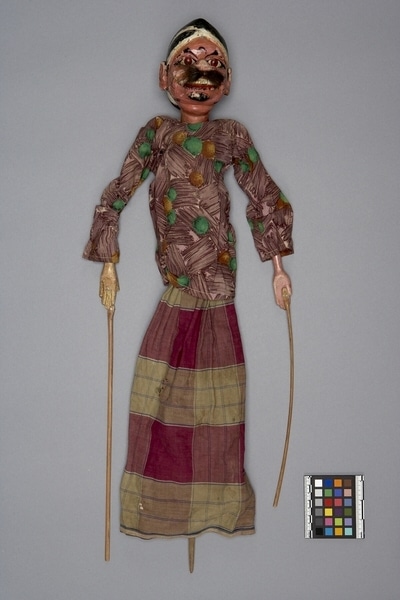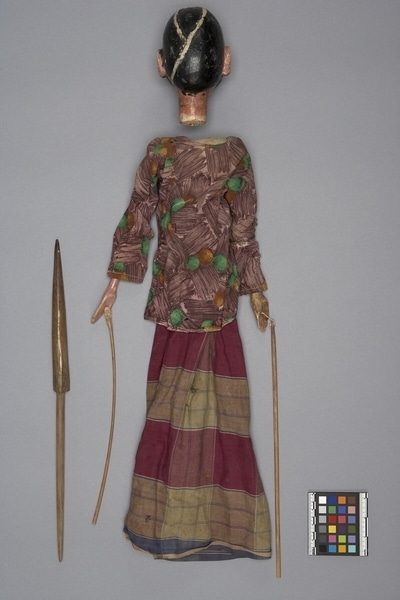Rod Puppet Item Number: Ib310 from the MOA: University of British Columbia


Description
Three-dimensional male humanoid puppet: large head (part b) fits into body with skirt (part a), and a control rod (part c) with a long shaft passes through the body and fits into the neck of the figure's head. The body has jointed arms, each with a long controlling rod attached. Figure has a pink face. Black turban with white trim on head. Red irises in white round eye sockets with heavy black eyebrows. Red lips with teeth showing, black hair moustache attached under the two round metal inserts at the corners of the mouth. Torso painted pink clothed in a purple, green and brown abstract pattern, and a long skirt in a purple, blue, green and brown plaid. The skirt is torn in places. Arm on left extends out fully, has residual gold paint on hand. Arm on right has a somewhat larger hand with residual pink paint. Arms attached by string to torso, with joints at the elbows.
History Of Use
Javanese puppetry as an art form probably developed by the 11th century. The three-dimensional wooden wayang golek puppets of western Java, which are to be distinguished from the earlier and more sacred wayang kulit shadow plays puppets or other forms, appeared during the 16th century. Originally the plays depicted Javanese mythology, but after the Indian conquest of Java the Hindu epics, Ramayana and Mahabharata, were incorporated into the cycles, which comprise about 200 plays. An individual or group hires a dalang (puppet-master) to celebrate important occasions. The performances often last all night and are generally presented in three acts, with vocal and instrumental accompaniment. The individual plays vary widely in detail but usually involve conflict between good and evil. They serve a moral and religious purpose, and more recently, one of political commentary. Each puppet's character is represented by its appearance and placement onstage; protagonists with strong elements of good are placed to the right, antagonists of violent or evil nature to the left. Character may be employed in a variety of roles limited by his conspicuous features. For instance, he could not be used as a prince or god, but could portray a servant, commoner, or be used in a crowd scene.
Cultural Context
Theatrical performance.
Iconographic Meaning
Large facial features, bulging eyes, bulbous nose, and extending teeth denote a less refined character, with many traits that may show arrogance, impiety, or perhaps evil nature. Clothing (loose top and skirt) without batik pattern likewise display an inauspicious character. Puppet not identified; perhaps a purposefully ambiguous character to allow the dalang to define its role. Possible conflicting colours on hands (pink and gold, representing angered and calm dispositions respectively) have no known significance.
Item History
- Made in Java, Indonesia
- Owned by Tradewind Antiques before March 15, 1983
- Received from Museum of Anthropology Shop Volunteers (Funding source) and Tradewind Antiques (Seller) on March 15, 1983
What
- Name
- Rod Puppet
- Identification Number
- Ib310
- Type of Item
- puppet
- Material
- wood, cotton fibre and paint
- Manufacturing Technique
- carved, machine woven, painted and sewn
- Part A
- height 65.0 cm, width 19.0 cm, depth 9.5 cm
- Part B
- height 15.3 cm, width 8.5 cm, depth 11.0 cm
- Part C
- height 43.0 cm, width 2.3 cm, depth 1.9 cm
Who
- Culture
- Sundanese
- Previous Owner
- Tradewind Antiques
- Received from
- Museum of Anthropology Shop Volunteers (Funding source) and Tradewind Antiques (Seller)
Where
- Holding Institution
- MOA: University of British Columbia
- Made in
- Java, Indonesia
When
- Ownership Date
- before March 15, 1983
- Acquisition Date
- on March 15, 1983
Other
- Condition
- fair
- Accession Number
- 0886/0044